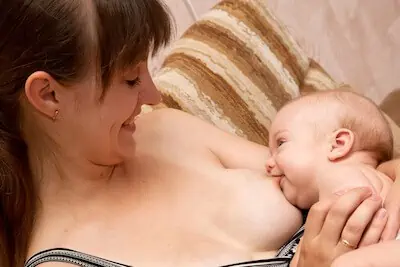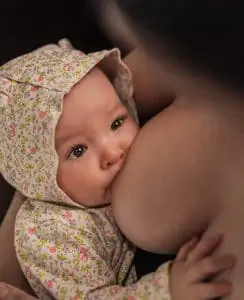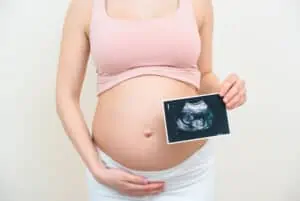If you’ve been reading this blog for a while, you know I’m a huge advocate for breastfeeding. It has many benefits for you and your baby, but of course, as much as you love your kids, you will want your old body back.
And that’s totally normal.
Since I’ve been busting breastfeeding myths lately, I wanted to understand the changes your body will undergo with breastfeeding. Consider it a heads up, a separation of fact and fiction, and a helping hand so you will learn some tips for minimizing any downward turns in breast shape.
I’ve listed a few of the most common questions I’ve heard, and then further below, I’ve got tips to help you keep things in place.
Does breastfeeding ruin your breast?
If I had a dollar for every time someone repeated this drivel, I’d be richer than Elon Musk. No, breastfeeding doesn’t ruin your breast shape. Breastfeeding will increase the size of your breasts due to the milk filling in them and your weight gain from carrying a baby.
But breastfeeding isn’t responsible for sagging breasts. It’s the pregnancy that does that to your breasts. So, even if you formula-fed your baby, your breasts could start to sag.
As you start losing that weight from carrying a baby, your breasts will begin to return to the ‘before’ look. However, if you drop weight too fast, wean too quickly, or don’t nourish your skin, you may see more sagging than your other breastfeeding friends.
Further below, I’ll tell you how to do your best to keep that from happening.
How does breastfeeding change your body?
Well, it’s actually your pregnancy that causes the changes to your body, not breastfeeding. When you’re pregnant, the levels of all those hormones like estrogen, progesterone, and prolactin all make their changes to your breast tissues. Your milk ducts expand, and blood flow increases to the area.
I was pretty pleased with my new, huge boobs. I had to get new bras to accommodate that big cup size. But of course, the loosening of the joints happens too, affecting your boobs. There are ligaments called Cooper’s ligaments that support the breast tissue. As your body readies itself for birth, the joints and ligaments loosen. This happens around your breasts as well.
Some women may start seeing stretch marks at this point around the breasts because of breast growth.

Your nipples change, too, getting darker and perhaps bigger. This is your body’s way of getting ready to feed your baby naturally. Remember, this all happens during pregnancy. It has nothing to do with breastfeeding except preparing your body to breastfeed successfully.
Now, where breastfeeding can change your breasts is in the breast tissue. Since your breasts may double or triple in size during lactation, this is where you need to be on the ball, especially if you had breast stretch marks and veins that appeared prominent during your pregnancy.
Increases in estrogen and that mammary development continue beyond pregnancy as you move into the postpartum phase. So, your breasts will look larger and fuller while breastfeeding, but when you wean, the ducts reduce in volume in breast tissue. Your skin may tighten up to suit this breast size, but if it isn’t elastic enough, it won’t.
A few factors come into play here as to whether or not this will happen. Your genetics, age, how much weight you’ve gained or lost, how many pregnancies you’ve had, the size of your original breasts, and if you smoke can impact how your breasts will change after breastfeeding.
Remember that even women who never get pregnant and have babies will have breasts that sag. Gravity will happen to all of us in due time. While we can’t change our genetics or age, those lifestyle factors have the potential to make or break our boob bounce.
Does your body go back to normal after breastfeeding?
Well, that depends on your version of normal. Lots of things change, but they don’t have to be bad!
For one, breastfeeding burns lots of calories. You will need to eat more, ideally nutritious foods, to sustain yourself. But once you stop breastfeeding, you will likely see that it’s easier to put on weight without making other changes.
Additionally, it will depend on whether you stop breastfeeding abruptly or gradually. Your hormones will change back to their pre-pregnancy levels once you stop breastfeeding, which takes about 6 to 8 weeks.
However, your hormones may make you sad and anxious, so be ready for that. They will adjust to normal, but you should talk to your doctor and have a support system to help you through this time.
Does pumping ruin the shape of your breasts?
Just as breastfeeding doesn’t ruin the shape of your breasts, your pump won’t either. You should provide good support to your larger breasts with a proper bra, keep active, and eat right. I’ve got more tips for you below on how to keep your boobs looking good after pregnancy and breastfeeding. But please know that the pump doesn’t cause sagging!
Does breastfeeding ruin your breast implants?
If you have augmented breasts, they will not be ruined by breastfeeding. If your implants are placed via an incision that has caused nerve damage or impacts your ducts, that may be the only concern to think of. But breastfeeding itself will not damage those implants. The breast tissue will keep them protected.
Don’t forget the benefits of breastfeeding
The CDC recommends breastfeeding, as does the American Academy of Pediatrics because it benefits you and your baby. Remember, breastmilk is the most nutritious thing to give your baby and can protect your child from illnesses in the short and long term. You’re giving your baby antibodies through this milk to keep them safe and build immunity.
Breastfeeding doesn’t have to schlep bottles, formula, and things everywhere. You can just feed your baby anytime and in any place. You’ll also enjoy a lower risk of certain diseases by breastfeeding. Things like breast and ovarian cancer, high blood pressure, and type 2 diabetes are less common for mothers who breastfeed.
How do I keep my breasts looking good after breastfeeding?
Well, you do have age and genetics to contend with, but there are some things you can do to keep your breasts looking good after you breastfeed.
Choose good bras
To help keep your breasts in a good place, you should support them with a good bra. If you wear bras that don’t fit well, especially when doing exercises, you could make the ligaments there stretch more.
Get your exercise
You CANNOT spot and treat a problem area. After you get that all-clear for exercise after having a baby, get moving. Lose that weight slowly and steadily, and support your boobs with suitable bras to help keep this area from sagging. You can also support your chest muscles, but that won’t stop sagging completely.
Take care of your skin
When you moisturize your skin, you help it stay elastic. This allows it to snap back into place. While this will be harder the older, you get, don’t skip this step so your skin can help you get back to your pre-baby body.
Get into the right nursing positions

While you’re still breastfeeding, make sure you’re supporting yourself well in those nursing positions. Don’t lean over or hang your breasts downward, or they will get droopier.
Slowly wean your baby
When you and your baby are ready to wean, you should do so gradually. This gives those fatty tissues plenty of time to redeposit into your breasts. Little by little, decrease how often you feed your baby by breast; this will help restore your breasts to how they looked before.
Incidentally, I’d like to mention that I think “ruin” isn’t a great term to throw around. We’re all beautifully different in our ways. We need to be happy inside of ourselves because youth is fleeting.
Remember, women that never had babies or were breastfed will still get saggy boobs. One day we’ll all be old and decrepit, if we get the luxury of living that long. The most important thing is good health and happiness, so take care of your health inside your body and outside on your skin.
Support your body with the right bras, exercise, and nourishing foods. This will minimize impact and allow you to give your baby the best start to life through breastmilk.
Leslie Berry lives with her husband and two young daughters in Los Altos, California, where she loves helping other moms get comfortable with motherhood and embracing the insanity with facts peppered with laughs.
She loves eating too much sushi, exercising, and jamming out on her Fender. Read more about Leslie here.






